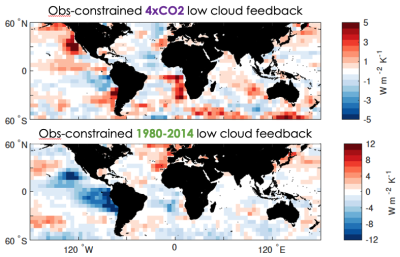Observational Constraints on the Cloud Feedback Pattern Effect
Scientists at Lawrence Livermore National Laboratory have determined from observations how much stronger the cloud feedback is in response to the homogeneous greenhouse warming pattern compared to that in response to the heterogeneous warming pattern observed recently. The team used real-world satellite observations to determine the sensitivity of clouds to their environmental controlling factors. Multiplying these sensitivities by the response of the controlling factors to recent (observed) warming trends and future (modeled) warming trends and taking their difference, the authors were able to constrain the degree to which the cloud feedback strength varies through time.
The team found that the cloud feedback expected under global warming is 0.78 Wm-2K-1 larger than would be inferred from recent changes between 1980 and 2014. This means that climate sensitivity inferred from recent observed changes underestimates the true climate sensitivity. These results provide the first-ever estimate of how strongly cloud feedback depends on warming patterns – a crucial step in further constraining climate sensitivity from the observational record.
Model evidence for the “pattern effect” assumes that global climate models (GCMs) faithfully simulate how clouds respond to varying sea-surface temperature (SST) patterns and associated meteorological perturbations. We exploit time-invariant satellite-based estimates of the sensitivity of marine low clouds to meteorological perturbations to estimate how these clouds responded to time-varying SST patterns and meteorology between 1870 and 2014. GCMs and reanalyses provide estimates of the historical meteorological changes. Observations suggest that increasing estimated inversion strength (EIS) between 1980 and 2014 produced a negative low cloud feedback, opposite to the positive feedback expected from increasing CO2. This indicates that the processes responsible for marine cloud changes from 1980 to near-present are distinct from those associated with an increase in CO2. We also observationally constrain the difference between the historical near-global marine low cloud feedback, λhist, and that arising from increasing CO2, λ4xCO2. We find that this cloud feedback pattern effect depends strongly on time period and reanalysis dataset and that varying changes in EIS and SST with warming explain much of its variability. Between 1980 and 2014, we estimate that λ4xCO2 − λhist = 0.78 ± 0.21 Wm−2K−1 (90% confidence) assuming meteorological changes from the Multiple-Reanaysis Ensemble, implying a total pattern effect (that arising from all climate feedbacks) of 1.86 ± 0.45 Wm−2K−1. This observational evidence corroborates previous quantitative estimates of the pattern effect, which heretofore relied largely upon GCM-based cloud changes. However, disparate historical meteorological changes across individual reanalyses contribute to considerable uncertainty in its magnitude.

